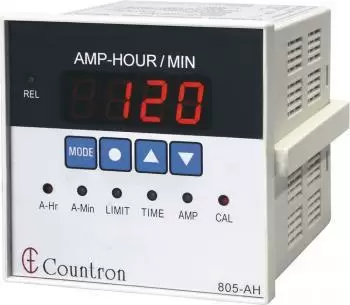
The ampere-hour (Ah) is a unit of measurement of electrical charge. It represents the amount of charge that passes through the terminals of a battery or electrical conductor when a current of 1 ampere (A) is supplied for 1 hour (h). Although it is a widely used unit in the field of batteries and electrical energy, it is not part of the International System of Units (SI), as is the hour.
Relationship between the ampere-hour and other units
In terms of electrical charge, 1 ampere-hour is equivalent to 3600 coulombs (C), since:
\[ 1 Ah = 1 A \times 3600 s = 3600 C \]
Where the coulomb (C) is the SI unit for electric charge and is defined as the amount of charge that flows through a conductor in 1 second when the current is 1 ampere.
Battery capacity and its relationship to amp-hours
The ampere-hour is primarily used to measure the capacity of batteries, indicating how much electricity they can store and supply. For example, a 100 Ah battery can theoretically:
- Supply 10A for 10 hours.
- Supply 1 A for 100 hours.
However, in practice, the effective capacity of a battery depends on several factors such as:
- Discharge rate: The faster the discharge, the more energy is lost due to internal resistance.
- Temperature conditions: Extreme cold may reduce battery capacity.
- Battery age and condition: Over time, batteries lose efficiency.
Measurement standards
Since a battery's capacity varies depending on the rate of discharge, manufacturers often specify Ah for a standard discharge rate (usually 10 or 20 hours). It is also common to specify the final voltage at which the battery is considered discharged.
Relationship with Faraday's constant
In electrochemical calculations, the Faraday constant is used, which represents the total charge carried by one mole of electrons. Its value is approximately 26.8 Ah per mole of electrons.
\[ F = 26.8 \text{ Ah/mol of electrons} \]
Expression in mAh and other units
For lower-power electronic devices such as mobile phones and smart watches, battery capacity is expressed in milliampere-hours (mAh):
\[ 1 Ah = 1000 mAh \]
For example:
- An 800mAh battery will have a lower capacity than a 3000mAh battery.
- Manufacturers may indicate the stored energy in Wh (watt-hours) instead of Ah, which involves considering the battery voltage: \( \text{Energy (Wh)} = \text{Capacity (Ah)} \times \text{Voltage (V)} \)
Examples of battery capacities
| Device/Battery | Typical capacity |
|---|---|
| AA battery | 2 - 3 Ah |
| Mobile phone | 2500 - 4000 mAh (2.5 - 4 Ah) |
| Car battery | 50 Ah or more |
| Electric bike battery | 10 - 20 Ah |
| Electric car battery | 50 - 100 Ah or more |